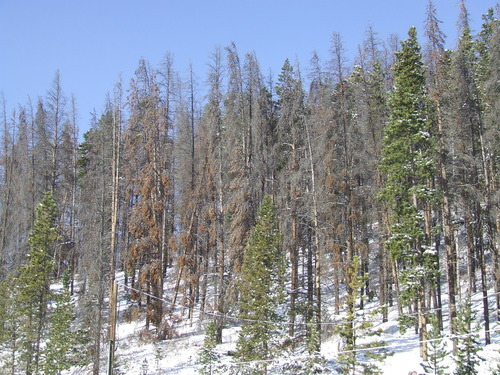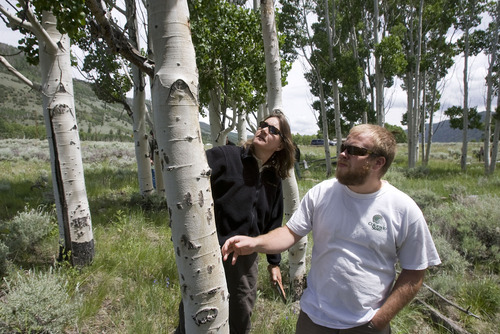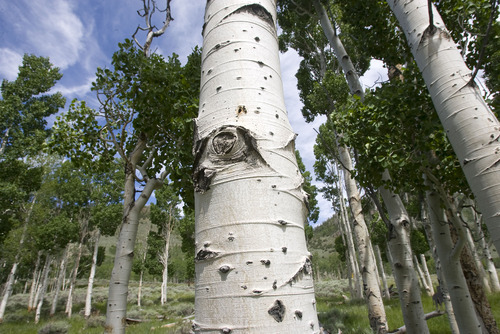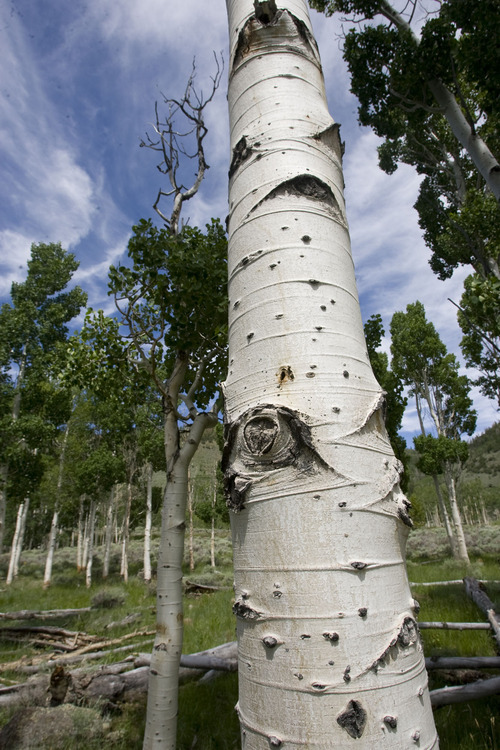This is an archived article that was published on sltrib.com in 2011, and information in the article may be outdated. It is provided only for personal research purposes and may not be reprinted.
Fish Lake • Utah's biggest biological curiosity is in trouble.
Make that the world's biggest.
So far, forest scientists say, no one has found any living thing bigger than the Pando clone, a 106-acre thicket of aspens arising from the same roots.
Bu living is not the most descriptive term for the white patch of trees at the south end of south central Utah's Fish Lake. Dying is more accurate.
"I call them the standing dead," said Kevin Mueller, program director for the Utah Environmental Congress and a participant in negotiations to revive the ancient network of trees.
The trouble is that thousands of linked aspens here are 100 to 150 years old and starting to topple. Young aspens aren't springing up from the root network as they have for hundreds or thousands of years (maybe more — scientists are unsure how long the complex has clung to the valley floor).
Interest groups and government foresters agree that whatever does grow here is getting munched by deer, elk, cattle or all three.
Across the highway is a slope of young aspens growing thickly, behind fencing that keeps out deer. Fishlake National Forest silviculturist Terry Holsclaw said that area was logged in the 1990s and responded nicely.
"We'd like to harvest [the Pando clone]," he said, "not for the economic value, but killing the bole of the tree is a good way to regenerate aspen."
After logging, the agency could fence out wildlife.
It's no guarantee of a rebound, though. It's unclear whether the root system remains healthy enough to send up sufficient suckers and fight off beetles, fungus and gnawing rodents.
"We probably don't have more than 10 years [to work] with this clone," Holsclaw said.
Options besides logging include ripping through some of the root segments with blades dragged on a tractor. Separating a root from the tree stimulates it to regrow a shoot. Another idea is to burn some of the area, though Holsclaw said that's tricky because of cabins and a historic lake lodge nearby.
Whatever the government decides to do next year, it will include fencing to protect the young trees.
Mueller remains hopeful about the program's results and also pleased that the government and ranchers are cooperating with researchers to help determine what's taking out more young aspens: deer, elk or cows. Cameras in aspen study plots next summer will document whether wildlife or cattle are spending more time there, he said, and one rancher suggested switching to sheep for a season to see if the accompanying guard dogs scare off deer and protect the trees.
Wildlife groups such as the National Wild Turkey Federation are helping with other restorations in the area. Federation biologist Stan Baker said his group is removing conifers where they're encroaching on aspens to save forest diversity and preserve grassy, shrubby openings.
"Aspen regeneration," he said, "is key for the wildlife."
The Pando benefits from name recognition and scientific interest that bring funding. It won't be possible to replicate everything that happens here across the West — deer-proof fencing for this clone alone is estimated up to $100,000 — but the project might help determine what works for aspen in the 21st century.
Its success will determine whether this grove holds its place among the world's giants.









